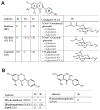Absorption, distribution, metabolism, and excretion of isoflavonoids after soy intake
- PMID: 24946051
- PMCID: PMC4439254
- DOI: 10.1016/j.abb.2014.06.007
Absorption, distribution, metabolism, and excretion of isoflavonoids after soy intake
Abstract
Soy is the major source of dietary exposure to isoflavonoids (IFLs). Accumulating evidence supports a role for soy and IFLs in the protection against many chronic diseases including cancer. After soy intake we found a biphasic IFL appearance pattern in plasma as well as in urine that we suggest to be due to IFL absorption in the small intestine (ca. 10%) during the first 2h after intake and IFL absorption in the large intestine (ca. 90%) 4-6 h after intake. While each IFL disappears from the circulation at different times excellent correlations between urinary and circulating IFL values were discovered and algorithms to convert urinary excretion values into circulating levels were established. We suggest the term 'apparent bioavailability' when using urinary data to describe IFL exposure. The IFL bioavailability was found to be influenced by gut bacteria, oral antibiotic treatment (OABX), and an individual's age and health status. While daidzein (DE) and genistein start to be absorbed minutes after intake, equol (EQ) appears in plasma only after a minimum of 8h following soy intake owing to the required transit time of DE to the colon where the conversion of DE to EQ takes place by intestinal microbiota. We have also shown that the apparent IFL bioavailability is higher in children than adults, higher in healthy versus non-healthy individuals, and decreased in children but increased in adults during OABX. Finally, we propose to use a urinary EQ/DE ratio of 0.018 with a DE threshold to identify EQ producers. With this cutoff definition we observed that EQ production is inconsistent over time in 5-30% of both premenopausal and postmenopausal women.
Keywords: Bioavailability; Daidzein; Equol; Genistein; Isoflavonoid; Soy.
Copyright © 2014 Elsevier Inc. All rights reserved.
Figures



References
Publication types
MeSH terms
Substances
Grants and funding
LinkOut - more resources
Full Text Sources
Other Literature Sources

